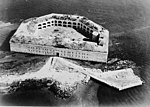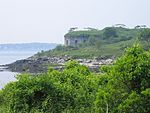Battle of Portland Harbor
19th century in Portland, MaineBattles and conflicts without fatalitiesBattles of the American Civil War in MaineBattles of the Eastern Theater of the American Civil WarJune 1863 events ... and 2 more
Naval battles of the American Civil WarUnion victories of the American Civil War

The Battle of Portland Harbor was an incident during the American Civil War, in June 1863, in the waters off Portland, Maine. Two civilian ships engaged two vessels under Confederate States Navy employment.
Excerpt from the Wikipedia article Battle of Portland Harbor (License: CC BY-SA 3.0, Authors, Images).Battle of Portland Harbor
North Landing Road, Portland Peaks Island
Geographical coordinates (GPS) Address Nearby Places Show on map
Geographical coordinates (GPS)
| Latitude | Longitude |
|---|---|
| N 43.663153 ° | E -70.221004 ° |
Address
Fort Gorges
North Landing Road
04109 Portland, Peaks Island
Maine, United States
Open on Google Maps









